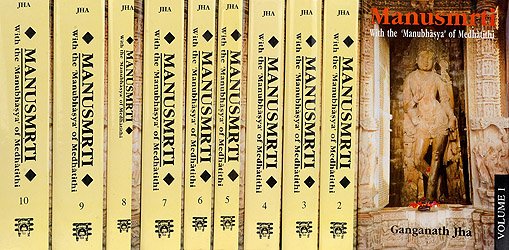Manusmriti with the Commentary of Medhatithi
by Ganganatha Jha | 1920 | 1,381,940 words | ISBN-10: 8120811550 | ISBN-13: 9788120811553
This is the English translation of the Manusmriti, which is a collection of Sanskrit verses dealing with ‘Dharma’, a collective name for human purpose, their duties and the law. Various topics will be dealt with, but this volume of the series includes 12 discourses (adhyaya). The commentary on this text by Medhatithi elaborately explains various t...
Verse 2.178
Sanskrit text, Unicode transliteration and English translation by Ganganath Jha:
अभ्यङ्गमञ्जनं चाक्ष्णोरुपानच्छत्रधारणम् ।
कामं क्रोधं च लोभं च नर्तनं गीतवादनम् ॥ १७८ ॥abhyaṅgamañjanaṃ cākṣṇorupānacchatradhāraṇam |
kāmaṃ krodhaṃ ca lobhaṃ ca nartanaṃ gītavādanam || 178 ||From anointing, applying collyrium to the eyes, shoes, holding the umbrella, attachment, anger, avarice, dancing, singing and playing on musical instruments.—(178)
Medhātithi’s commentary (manubhāṣya):
‘Anointing’—rubbing of the head and body with butter, oil or such other oily substances.
‘Applying collyrium to the eyes—the addition of the word ‘eyes’ is only for the purpose of filling up the metre.
What is prohibited in regard to these two is the having recourse to them by way of ornamentation; and not their use as medicine. That this is so is. dear from their being mentioned along with ‘scents and garlands.’
‘Shoes’—foot-covers made of leather; not all kinds of foot-cover.
‘Holding of the umbrella’—either by one’s own hand or by the hand of another person; both are prohibited.
‘Kāma’ here stands for attachment; the preclusion of sexual desire being already included under the prohibition of association with women (in 177).
‘Anger’—rage.
‘Avarice’—selfishness. Notions of ‘I’ and ‘mine’ are the characteristics of the mind.
‘Dancing.’—The throwing about of one’s limbs for the delectation of ordinary people, as also the acting of dramas according to the rules laid down by Bharata and others.
‘Singing’—the exhibition of the ‘Ṣaḍja’ and other musical notes.
‘Playing upon musical instruments,'—the producing of musical sounds by means of the lute, the flute and so forth, as also the striking, to time, of such instruments as the drum, mṛdaṅga and the like.—(178)
Explanatory notes by Ganganath Jha
This is quoted in Parāśaramādhava (Ācāra, p. 456);—in Madanapārijāta (p. 39);—in Vīramitrodaya (Saṃskāra, p. 494);—in Nirṇayasindhu (p. 189);—in Aparārka (p. 62);—in Saṃskāramayūkha (p. 42);—and in Smṛticandrikā (Saṃskāra, p. 125).
Comparative notes by various authors
(verses 177-179)
See Comparative notes for Verse 2.177.
